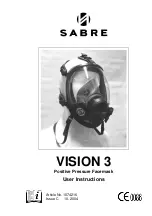
ABEM Terrameter SAS 1000 / SAS 4000
- 66 -
The selection of resistivity interval limits is of major importance when presenting data, as the
perception of the plotted data is strongly controlled by the colours. A suitable selection of
limits may enhance the geological variation, while an unsuitable selection may hide important
information or enhance irrelevant features. Obviously it may be necessary to have geological
reference for optimising the data presentation. The character of resistivity data often makes it
suitable to use a logarithmic distribution between the resistivity intervals.
The example of a pseudosection plot in Figure 18 shows the response of a vertical contact,
with 10
m to the left of the contact and 100
m to the right. The example shows
analytically calculated model response (Carpenter, 1955), and emulates data sampled in a
pattern similar to that of the data collection system. The example points out the importance of
being aware of the strong lateral effects on DC-resistivity data of vertical discontinuities when
interpreting pseudosections, and the necessity of using inverse modelling (inversion) to get an
image that reflects the true geometry of the investigated object.
The software was developed for plotting of DC-resistivity data measured with a multi-
electrode array, implying that electrode spacing are always an integer multiple of the smallest
electrode spacing used. Furthermore, profile distance coordinates are assumed to fall into the
same positions as data for the smallest electrode spacing or halfway between them. If data
stored in another geometrical pattern is plotted with the program it may not function properly.
To view the converted data file as a pseudosection run ERIGRAPH and select open data file.
By clicking the “Edit diagram settings” icon, or by right click on the diagram window, the
settings menu below will appear with various plot options.
Figure 18.
Example of a Wenner pseudosection plot showing analytical response of a
single vertical contact (10
m and 100
m), with data sampled as field data.
















































